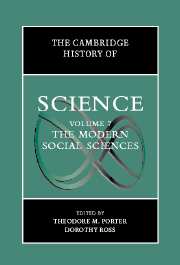Book contents
- Frontmatter
- 1 Introduction: Writing the History of Social Science
- PART I SCIENCES OF THE SOCIAL TO THE LATE NINETEENTH CENTURY
- PART II THE DISCIPLINES IN WESTERN EUROPE AND NORTH AMERICA SINCE ABOUT 1880
- 13 Changing Contours of The Social Science Disciplines
- 14 Statistics and Statistical Methods
- 15 Psychology
- 16 Economics
- 17 Political Science
- 18 Sociology
- 19 Anthropology
- 20 Geography
- 21 History and the Social Sciences
- PART III THE INTERNATIONALIZATION OF THE SOCIAL SCIENCES
- PART IV SOCIAL SCIENCE AS DISCOURSE AND PRACTICE IN PUBLIC AND PRIVATE LIFE
- Index
- References
20 - Geography
from PART II - THE DISCIPLINES IN WESTERN EUROPE AND NORTH AMERICA SINCE ABOUT 1880
Published online by Cambridge University Press: 28 March 2008
- Frontmatter
- 1 Introduction: Writing the History of Social Science
- PART I SCIENCES OF THE SOCIAL TO THE LATE NINETEENTH CENTURY
- PART II THE DISCIPLINES IN WESTERN EUROPE AND NORTH AMERICA SINCE ABOUT 1880
- 13 Changing Contours of The Social Science Disciplines
- 14 Statistics and Statistical Methods
- 15 Psychology
- 16 Economics
- 17 Political Science
- 18 Sociology
- 19 Anthropology
- 20 Geography
- 21 History and the Social Sciences
- PART III THE INTERNATIONALIZATION OF THE SOCIAL SCIENCES
- PART IV SOCIAL SCIENCE AS DISCOURSE AND PRACTICE IN PUBLIC AND PRIVATE LIFE
- Index
- References
Summary
During the late nineteenth century, geography was institutionalized as a discipline with ties to both nature and culture, but it was divided into several distinct national schools and competing currents of thought. The chronology of ruptures over the past century also differed by country: The notion of a “modern” geography took hold in the early 1900s, while the diffusion of what was called the “new geography” occurred during the 1950s and 1960s in the United States, and during the 1970s in continental Europe. At the dawn of the twenty-first century, the expansion of geography had not altered the segmentation of the discipline. Nonetheless, several general tendencies – geographic, epistemological, and institutional – transformed the discipline during the second half of the twentieth century. Geographically, the center of gravity of the discipline shifted after the Second World War from the countries of “Old Europe,” where it had first flourished – in Germany, France, and Great Britain – toward the United States and the Anglophone world. Beginning during the same postwar period, geography was incorporated into the human sciences rather than the earth sciences, to which it had earlier been attached, inaugurating a greater variety of practices and interactions with the social sciences, especially economics, although after 1980 geography also began to explore its links with the humanities. Finally, the development of new markets after 1950 diversified this formerly professorial discipline, so that training in geography became oriented toward spatial planning, the environment, geopolitics, and social expertise.
- Type
- Chapter
- Information
- The Cambridge History of Science , pp. 379 - 390Publisher: Cambridge University PressPrint publication year: 2003
References
- 8
- Cited by



